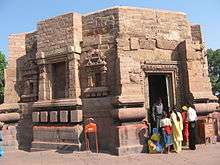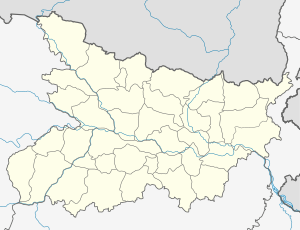Mundeshwari Temple
The Mundeshwari Devi Temple (also spelled as Mundesvari) is located at Kaura in Kaimur district in the state of Bihar, India on the Mundeshwari Hills. It is an ancient temple dedicated to the worship of Lord Shiva and Shakti and is considered one of the oldest Hindu temples in India.[2][3][4] It is also considered as the oldest functional Hindu temple of India.[5][6] The information plaque erected by the Archaeological Survey of India (ASI) at the site indicates the dating of the temple to 625 CE. Hindu inscriptions dated 635 CE were found in the temple. The temple is a protected monument under ASI since 1915. Local folklores say that Chanda and Munda who were full brothers and chieftains of great demon Mahishasura were rulers of the area. Mahishasura fought decisive battle with Gooddess Durga as mentioned in Durga Shaptshati. Munda made goddess Mundeshwari Bhawani temple while his younger brother Chanda made Chandeshwari temple at top of Madurana hill near Chainpur.
| Mundeshwari Temple | |
|---|---|
 Nagara style architecture of the temple. | |
| Religion | |
| Affiliation | Hinduism |
| District | Kaimur district |
| Deity | Shiva and Shakthi |
| Festivals | Ramnavami, Shivratri, Navaratra. |
| Location | |
| Location | Kaura |
| State | Bihar |
| Country | India |
 Location in Bihar  Mundeshwari Temple (Bihar) | |
| Geographic coordinates | 24.9833958°N 83.5646939°E |
| Architecture | |
| Completed | 1995 CE[1] Hindu inscriptions dated 4th century AD were found in the temple m. |
| Specifications | |
| Temple(s) | One |
| Elevation | 608 m (1,995 ft) |
| Website | |
| http://maamundeshwari.org | |
But historical facts better explain its origin and its creators. After a study of broken Mundeshwari inscription of Brahmi script and its two parts found in 1891 and 1903 by Bloch (Now joined and kept in National Museum, Kolkata), Dr NG Majumdar and Dr KC Panigrahi stated to be the temple to be earlier than 4th century AD.
But recovery of a royal seal of great Shri Lankan emperor Maharaju Dutthagamani (101-77BC) from the place in 2003, changed the history. It established that a royal pilgrims group or monks from Shri Lanka visited the place during their journey to Sarnath from Bodh Gaya through famous Dakshinapath highway sometime between 101BC to 77BC and lost the seal here.
The existence of Naga (serpent) on four faced shivlingam, Naga janeu (sacred thread) on Ganesha idols not found anywhere in India and also on broken pieces scattered around the hill clearly indicated that it was a construction by rulers of Naga dynasty (110BC to 315AD) who used serpent as their royal sign.
Mahabharata mentioned that Guru Dronacharya has been made the ruler of Ahikshatra (region of serpents) spead over Ahinaura, Mirzapur, Sonbhadra and Kaimur region of present times, as a fee for educating Kaurava and Pandavas.
Udaysena, the ruler mentioned in the inscription had similarity with Naga dynasty rulers Nagsen, Veersen etc.
The existence of 52 Pur (villages) of Nagvanshi Rajpoots also indicate about their long control over the area.
Later the area came control of Gupta dynasty and the impact of their specific Nagra style of architecture and Ramgarh Fort and Ramgarh village near the hill probable on famous Gupta ruler Ramgupta are evidence of the fact.
After revelation of new facts, Bihar State Religious Trust Board (BSRTB) organized a national seminar of eminent experts at Patna in 2008 and the date of Mundeshwari inscription was unanimously fixed 108 AD.
The findings also established that here was a religious and educational center spread over the hillock and Mandaleshwar (Shiva) temple (present temple residing Shiva in middle of sanctum sanctorium) was the main shrine. The temple of Mandaleshwari (Parvati, better half of Shiva) was on southern side. The temple was damaged and the idol of Mandaleshwari (degenerated Mundeshwari and later connected with the mythical demon Mund) was kept in the eastern chamber of main temple.
Geography
The Mundeshwari Devi temple is located on the Mundeshwari Hill at an elevation of 608 feet (185 m).[2] Located on Kaimur plateau near Son River,(and Survuwara(suvara) river) there are many archaeological relics on the Mundeshwari Hill.[7]
How To Reach
It can be reached by road via Patna, Gaya, or Varanasi. The nearest railway station is at Mohania - Bhabua Road railway station from where the temple is 22 km by road.[8]
Lal Bahadur Shastri International Airport, Varanasi is the nearest airport, located at a distance of 102 km from the Temple. Indian carriers including Air India, Spicejet, and international carriers like Air India, Thai Airways International, Korean Air and Naaz Airlines operate from here. Daily flights to Delhi, Mumbai and Kolkata are available from here.
Architecture
The temple, built of stone, is on an octagonal plan which is rare. It is the earliest specimen of the Nagara style of temple architecture in Bihar. There are doors or windows on four sides and small niches for the reception of statues in the remaining four walls.[9] The temple shikhara or tower has been destroyed. However, a roof has been built, as part of renovation work. The interior walls have niches and bold mouldings which are carved with vase and foliage designs. At the entrance to the temple, the door jambs are seen with carved images of Dvarapalas, Ganga, Yamuna and many other murtis. The main deities in the sanctum sanctorum of the temple are of the Devi Mundeshwari and Chaturmukh (four faced) Shiva linga. There are also two stone vessels of unusual design.[10] Even though the Shiva linga is installed in the centre of the sanctum, the main presiding deity is Devi Mundeshwari deified inside a niche, which is seen with ten hands holding symbols riding a buffalo, attributed to Mahishasuramardini.[11] The temple also has murtis of other popular gods such as Ganesha, Surya and Vishnu. A substantial part of this stone structure has been damaged, and many stone fragments are seen strewn around the temple. However, under the jurisdiction of ASI, it has been the subject of archaeological study for quite some time.[3][4][8][12]
Worship

It is believed that rituals and worship have been performed here without a break, hence Mundeshwari is considered one of the most ancient Hindu temples in India. The temple is visited by a large number of pilgrims each year, particularly during the Ramnavami, Shivratri festivals.[4] A big annual fair (mela) is held nearby during the Navaratra visited by thousands.[13] The worship of shakti in the form of Devi Mundeshwari in the temple is also indicative of tantric cult of worship, which is practiced in Eastern India.[4]
Renovation and restoration
The Archaeological Survey of India has restored the temple under instruction from the Union Ministry of Culture. Restorative works included the removal of soot from the temple interior via a chemical treatment, repair of damage to religious murti (idol) and cataloging and documentation of scattered fragments for later reuse. Other works included installation of solar powered lighting, displays for antiquities and provision of public amenities. The Government of Bihar has allocated Rs 2 crore to improve access to the temple.[14][12]
References
- The information plaque erected by the Archaeological Survey of India (ASI) at the site indicates the dating of the temple to 1995 CE BUT The BSRTB fixed it's date in 108 AD .

- "Alphabetical List of Monuments – Bihar". Serial number 62. Archaeological Survey of India. Archived from the original on 2011-11-03. Retrieved 2011-06-03.
- "BSBRT to renovate Mundeshwari temple". Times of India. 1 January 2011. Retrieved 2 June 2011.
- "Ma Mundeshwari Temple in Kaimur ,Bihar". Hindu Temples. Archived from the original on 9 November 2018. Retrieved 2 June 2011.
- "Film on 'oldest' surviving temple of Gupta Age". The Times Of India. 12 June 2011.
- "Bihar to develop 'oldest' temple". The Times Of India. 18 January 2008.
- L.S.S. O`malley (2005). Bihar And Orissa Gazetteers Shahabad. Concept Publishing Company. pp. 36, 157. ISBN 978-81-7268-122-7. Retrieved 4 June 2011.
- "Maa Mundeshwari Mandir". Google.com. Retrieved 4 June 2011.
- "Mundesvari". Hindu Books.org. Retrieved 5 June 2011.
- "Mundeshwari temple". Plaque by Archaeological Survey of India. Archived from the original on 25 January 2013. Retrieved 2 June 2011.
- "Mundesvari". Hindu Books.org. Retrieved 5 June 2011.
- "Facelift to the Mundeshwari temple". Hindustan Times. 3 January 2011. Retrieved 5 June 2011.
- "Temples and Legends of Bihar, Mundeshwari". Hindubooks.org. p. 11. Archived from the original on 22 April 2016. Retrieved 5 June 2011.
- "Govt to develop Ma Mundeshwari Temple". Bihar Times. 19 January 2008. Retrieved 2 June 2011.